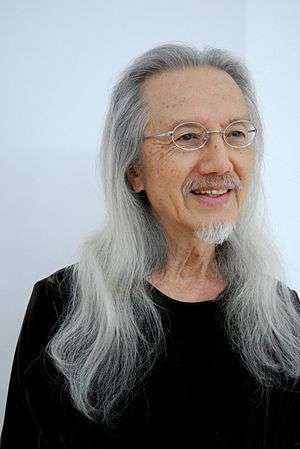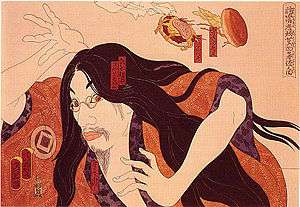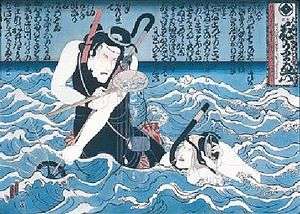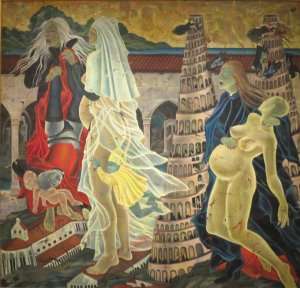Masami Teraoka




Masami Teraoka (born 1936) is a Japanese-American contemporary artist. His work includes ukiyo-e-influenced woodcuts and paintings.
Biography
Teraoka was born in the town of Onomichi in Hiroshima Prefecture. He studied from 1954–59 at the Kwansei Gakuin University in Kobe, Japan where he received his B.A. in Aesthetics. He moved to the United States in 1961 and from 1964–68 attended the Otis Art Institute now the Otis College of Art and Design in Los Angeles, where he received a B.F.A. and M.F.A. Masami's wife Lynda Hess is also a painter.
Works
His early work consisted primarily of watercolor paintings and prints that mimicked the flat, bold qualities of ukiyo-e woodblock prints. These paintings, done after his arrival in the United States, often featured the collision of the two cultures. Series such as McDonald's Hamburgers Invading Japan and 31 Flavors Invading Japan characterize themes in the work in this time period. These pieces blended reality with fantasy, humor with commentary, history with the present.
In the 1980s, Teraoka shifted palette and scale to depict AIDS as a subject, transforming his ukiyo-e derived paintings into a darker realm. Since the late 1990s, he has been producing large-scale narrative paintings inspired by well-known Renaissance paintings, rather than by Japanese woodblock prints. These paintings reference social and political issues, such as the September 11 attacks and abuse in the Catholic Church. The Cloisters / Tsunami in the collection of the Honolulu Museum of Art, depicts Towers of Babel as the twin towers of the World Trade Center and fallen priests. This painting also includes a self-portrait in the left upper corner.[1]
Teraoka has been the subject of more than 70 solo exhibitions, many of which have traveled extensively, including those organized by the Whitney Museum of American Art in 1980; The Contemporary Museum, Honolulu (now known as the Honolulu Museum of Art Spalding House) in 1988; and the Yale University Art Gallery in 1998. Also in 1996 he was featured in a solo exhibition at the Arthur M. Sackler Gallery, Smithsonian Institution and in 1997 at the Asian Art Museum, San Francisco.
His work is in more than 50 public collections worldwide, including the Fine Arts Museums of San Francisco; the Asian Art Museum of San Francisco; the Smithsonian American Art Museum, Washington D. C.; the Honolulu Museum of Art, Hawaii; the Los Angeles County Museum of Art; the Metropolitan Museum of Art, New York; the National Portrait Gallery, Washington D. C.; Tate Modern, London, England; the Queensland Art Gallery/GOMA, Brisbane, Australia; the Gallery of Modern Art, Glasgow, Scotland; and the Singapore Art Museum, Singapore. Masami Teraoka has twice been honored by the American Academy of Arts and Letters, New York and received two fellowships from the National Endowment for the Arts. The first comprehensive monograph on the artist was published in 2007.[2]
Masami Teraoka has given lectures at the Whitney Museum of American Art, the Asian Art Society, the Institute of Fine Arts/NYU, and Brown University, among many others, and has received a number of grants and awards. He has also completed numerous commissioned pieces, including a painting, Samurai Businessmen for the cover of TIME Magazine, and Green Rabbit Island for the State Foundation for the Arts and Culture, Honolulu, Hawaii.He is represented by the Catharine Clark Gallery in San Francisco since 1997 and Samuel Freeman in Los Angeles.
Scheduled exhibitions include:
- Fall 2010 September 25 - November 6, 2010. Solo Exhibition at Catharine Clark Gallery, San Francisco, California
- Fall 2012 September 8 - October 13, 2012. Solo Exhibition at Samuel Freeman, Los Angeles, California
- Fall 2012 East of Eden, West of Hell. Solo exhibition curated by Theresa Papanikolas at the Honolulu Academy of Arts, Honolulu, Hawaii
- Solo Exhibition at the Mizuma and One-Gallery, Beijing, China
References
- Chang, Gordon H., Mark Dean Johnson, Paul J. Karlstrom & Sharon Spain, Asian American Art, a History, 1850-1970, Stanford University Press, ISBN 9780804757515, pp. 432–434
- Clarke, Joan and Diane Dods, Artists/Hawaii, Honolulu, University of Hawaii Press, 1996, 104-109.
- Freeman, Samuel, Peter Clothier and Marcia Morse, Masami Teraoka: Cloisters' Confession, Santa Monica, Samuel Freeman, 2008.
- Link, Howard A., Waves and Plagues, The Art of Masami Teraoka, San Francisco, Chronicle Books, 1988.
- Teraoka, Masami, Masami Teraoka, New York, Whitney Museum of American Art, 1979.
- Teraoka, Masami, Masami Teraoka, From Tradition to Technology, The Floating World Comes of Age, Seattle, Washington, University of Washington Press, 1997.
- Teraoka, Masami, Paintings by Masami Teraoka, Washington, DC, Arthur M. Sackler Gallery, Smithsonian Institution, 1996.
- Yoshihara, Lisa A., Collective Visions, 1967-1997, Hawaii State Foundation on Culture and the Arts, Honolulu, Hawaii, 1997, 131.